

Understanding Assignments
What this handout is about.
The first step in any successful college writing venture is reading the assignment. While this sounds like a simple task, it can be a tough one. This handout will help you unravel your assignment and begin to craft an effective response. Much of the following advice will involve translating typical assignment terms and practices into meaningful clues to the type of writing your instructor expects. See our short video for more tips.
Basic beginnings
Regardless of the assignment, department, or instructor, adopting these two habits will serve you well :
- Read the assignment carefully as soon as you receive it. Do not put this task off—reading the assignment at the beginning will save you time, stress, and problems later. An assignment can look pretty straightforward at first, particularly if the instructor has provided lots of information. That does not mean it will not take time and effort to complete; you may even have to learn a new skill to complete the assignment.
- Ask the instructor about anything you do not understand. Do not hesitate to approach your instructor. Instructors would prefer to set you straight before you hand the paper in. That’s also when you will find their feedback most useful.
Assignment formats
Many assignments follow a basic format. Assignments often begin with an overview of the topic, include a central verb or verbs that describe the task, and offer some additional suggestions, questions, or prompts to get you started.
An Overview of Some Kind
The instructor might set the stage with some general discussion of the subject of the assignment, introduce the topic, or remind you of something pertinent that you have discussed in class. For example:
“Throughout history, gerbils have played a key role in politics,” or “In the last few weeks of class, we have focused on the evening wear of the housefly …”
The Task of the Assignment
Pay attention; this part tells you what to do when you write the paper. Look for the key verb or verbs in the sentence. Words like analyze, summarize, or compare direct you to think about your topic in a certain way. Also pay attention to words such as how, what, when, where, and why; these words guide your attention toward specific information. (See the section in this handout titled “Key Terms” for more information.)
“Analyze the effect that gerbils had on the Russian Revolution”, or “Suggest an interpretation of housefly undergarments that differs from Darwin’s.”
Additional Material to Think about
Here you will find some questions to use as springboards as you begin to think about the topic. Instructors usually include these questions as suggestions rather than requirements. Do not feel compelled to answer every question unless the instructor asks you to do so. Pay attention to the order of the questions. Sometimes they suggest the thinking process your instructor imagines you will need to follow to begin thinking about the topic.
“You may wish to consider the differing views held by Communist gerbils vs. Monarchist gerbils, or Can there be such a thing as ‘the housefly garment industry’ or is it just a home-based craft?”
These are the instructor’s comments about writing expectations:
“Be concise”, “Write effectively”, or “Argue furiously.”
Technical Details
These instructions usually indicate format rules or guidelines.
“Your paper must be typed in Palatino font on gray paper and must not exceed 600 pages. It is due on the anniversary of Mao Tse-tung’s death.”
The assignment’s parts may not appear in exactly this order, and each part may be very long or really short. Nonetheless, being aware of this standard pattern can help you understand what your instructor wants you to do.
Interpreting the assignment
Ask yourself a few basic questions as you read and jot down the answers on the assignment sheet:
Why did your instructor ask you to do this particular task?
Who is your audience.
- What kind of evidence do you need to support your ideas?
What kind of writing style is acceptable?
- What are the absolute rules of the paper?
Try to look at the question from the point of view of the instructor. Recognize that your instructor has a reason for giving you this assignment and for giving it to you at a particular point in the semester. In every assignment, the instructor has a challenge for you. This challenge could be anything from demonstrating an ability to think clearly to demonstrating an ability to use the library. See the assignment not as a vague suggestion of what to do but as an opportunity to show that you can handle the course material as directed. Paper assignments give you more than a topic to discuss—they ask you to do something with the topic. Keep reminding yourself of that. Be careful to avoid the other extreme as well: do not read more into the assignment than what is there.
Of course, your instructor has given you an assignment so that they will be able to assess your understanding of the course material and give you an appropriate grade. But there is more to it than that. Your instructor has tried to design a learning experience of some kind. Your instructor wants you to think about something in a particular way for a particular reason. If you read the course description at the beginning of your syllabus, review the assigned readings, and consider the assignment itself, you may begin to see the plan, purpose, or approach to the subject matter that your instructor has created for you. If you still aren’t sure of the assignment’s goals, try asking the instructor. For help with this, see our handout on getting feedback .
Given your instructor’s efforts, it helps to answer the question: What is my purpose in completing this assignment? Is it to gather research from a variety of outside sources and present a coherent picture? Is it to take material I have been learning in class and apply it to a new situation? Is it to prove a point one way or another? Key words from the assignment can help you figure this out. Look for key terms in the form of active verbs that tell you what to do.
Key Terms: Finding Those Active Verbs
Here are some common key words and definitions to help you think about assignment terms:
Information words Ask you to demonstrate what you know about the subject, such as who, what, when, where, how, and why.
- define —give the subject’s meaning (according to someone or something). Sometimes you have to give more than one view on the subject’s meaning
- describe —provide details about the subject by answering question words (such as who, what, when, where, how, and why); you might also give details related to the five senses (what you see, hear, feel, taste, and smell)
- explain —give reasons why or examples of how something happened
- illustrate —give descriptive examples of the subject and show how each is connected with the subject
- summarize —briefly list the important ideas you learned about the subject
- trace —outline how something has changed or developed from an earlier time to its current form
- research —gather material from outside sources about the subject, often with the implication or requirement that you will analyze what you have found
Relation words Ask you to demonstrate how things are connected.
- compare —show how two or more things are similar (and, sometimes, different)
- contrast —show how two or more things are dissimilar
- apply—use details that you’ve been given to demonstrate how an idea, theory, or concept works in a particular situation
- cause —show how one event or series of events made something else happen
- relate —show or describe the connections between things
Interpretation words Ask you to defend ideas of your own about the subject. Do not see these words as requesting opinion alone (unless the assignment specifically says so), but as requiring opinion that is supported by concrete evidence. Remember examples, principles, definitions, or concepts from class or research and use them in your interpretation.
- assess —summarize your opinion of the subject and measure it against something
- prove, justify —give reasons or examples to demonstrate how or why something is the truth
- evaluate, respond —state your opinion of the subject as good, bad, or some combination of the two, with examples and reasons
- support —give reasons or evidence for something you believe (be sure to state clearly what it is that you believe)
- synthesize —put two or more things together that have not been put together in class or in your readings before; do not just summarize one and then the other and say that they are similar or different—you must provide a reason for putting them together that runs all the way through the paper
- analyze —determine how individual parts create or relate to the whole, figure out how something works, what it might mean, or why it is important
- argue —take a side and defend it with evidence against the other side
More Clues to Your Purpose As you read the assignment, think about what the teacher does in class:
- What kinds of textbooks or coursepack did your instructor choose for the course—ones that provide background information, explain theories or perspectives, or argue a point of view?
- In lecture, does your instructor ask your opinion, try to prove their point of view, or use keywords that show up again in the assignment?
- What kinds of assignments are typical in this discipline? Social science classes often expect more research. Humanities classes thrive on interpretation and analysis.
- How do the assignments, readings, and lectures work together in the course? Instructors spend time designing courses, sometimes even arguing with their peers about the most effective course materials. Figuring out the overall design to the course will help you understand what each assignment is meant to achieve.
Now, what about your reader? Most undergraduates think of their audience as the instructor. True, your instructor is a good person to keep in mind as you write. But for the purposes of a good paper, think of your audience as someone like your roommate: smart enough to understand a clear, logical argument, but not someone who already knows exactly what is going on in your particular paper. Remember, even if the instructor knows everything there is to know about your paper topic, they still have to read your paper and assess your understanding. In other words, teach the material to your reader.
Aiming a paper at your audience happens in two ways: you make decisions about the tone and the level of information you want to convey.
- Tone means the “voice” of your paper. Should you be chatty, formal, or objective? Usually you will find some happy medium—you do not want to alienate your reader by sounding condescending or superior, but you do not want to, um, like, totally wig on the man, you know? Eschew ostentatious erudition: some students think the way to sound academic is to use big words. Be careful—you can sound ridiculous, especially if you use the wrong big words.
- The level of information you use depends on who you think your audience is. If you imagine your audience as your instructor and they already know everything you have to say, you may find yourself leaving out key information that can cause your argument to be unconvincing and illogical. But you do not have to explain every single word or issue. If you are telling your roommate what happened on your favorite science fiction TV show last night, you do not say, “First a dark-haired white man of average height, wearing a suit and carrying a flashlight, walked into the room. Then a purple alien with fifteen arms and at least three eyes turned around. Then the man smiled slightly. In the background, you could hear a clock ticking. The room was fairly dark and had at least two windows that I saw.” You also do not say, “This guy found some aliens. The end.” Find some balance of useful details that support your main point.
You’ll find a much more detailed discussion of these concepts in our handout on audience .
The Grim Truth
With a few exceptions (including some lab and ethnography reports), you are probably being asked to make an argument. You must convince your audience. It is easy to forget this aim when you are researching and writing; as you become involved in your subject matter, you may become enmeshed in the details and focus on learning or simply telling the information you have found. You need to do more than just repeat what you have read. Your writing should have a point, and you should be able to say it in a sentence. Sometimes instructors call this sentence a “thesis” or a “claim.”
So, if your instructor tells you to write about some aspect of oral hygiene, you do not want to just list: “First, you brush your teeth with a soft brush and some peanut butter. Then, you floss with unwaxed, bologna-flavored string. Finally, gargle with bourbon.” Instead, you could say, “Of all the oral cleaning methods, sandblasting removes the most plaque. Therefore it should be recommended by the American Dental Association.” Or, “From an aesthetic perspective, moldy teeth can be quite charming. However, their joys are short-lived.”
Convincing the reader of your argument is the goal of academic writing. It doesn’t have to say “argument” anywhere in the assignment for you to need one. Look at the assignment and think about what kind of argument you could make about it instead of just seeing it as a checklist of information you have to present. For help with understanding the role of argument in academic writing, see our handout on argument .
What kind of evidence do you need?
There are many kinds of evidence, and what type of evidence will work for your assignment can depend on several factors–the discipline, the parameters of the assignment, and your instructor’s preference. Should you use statistics? Historical examples? Do you need to conduct your own experiment? Can you rely on personal experience? See our handout on evidence for suggestions on how to use evidence appropriately.
Make sure you are clear about this part of the assignment, because your use of evidence will be crucial in writing a successful paper. You are not just learning how to argue; you are learning how to argue with specific types of materials and ideas. Ask your instructor what counts as acceptable evidence. You can also ask a librarian for help. No matter what kind of evidence you use, be sure to cite it correctly—see the UNC Libraries citation tutorial .
You cannot always tell from the assignment just what sort of writing style your instructor expects. The instructor may be really laid back in class but still expect you to sound formal in writing. Or the instructor may be fairly formal in class and ask you to write a reflection paper where you need to use “I” and speak from your own experience.
Try to avoid false associations of a particular field with a style (“art historians like wacky creativity,” or “political scientists are boring and just give facts”) and look instead to the types of readings you have been given in class. No one expects you to write like Plato—just use the readings as a guide for what is standard or preferable to your instructor. When in doubt, ask your instructor about the level of formality they expect.
No matter what field you are writing for or what facts you are including, if you do not write so that your reader can understand your main idea, you have wasted your time. So make clarity your main goal. For specific help with style, see our handout on style .
Technical details about the assignment
The technical information you are given in an assignment always seems like the easy part. This section can actually give you lots of little hints about approaching the task. Find out if elements such as page length and citation format (see the UNC Libraries citation tutorial ) are negotiable. Some professors do not have strong preferences as long as you are consistent and fully answer the assignment. Some professors are very specific and will deduct big points for deviations.
Usually, the page length tells you something important: The instructor thinks the size of the paper is appropriate to the assignment’s parameters. In plain English, your instructor is telling you how many pages it should take for you to answer the question as fully as you are expected to. So if an assignment is two pages long, you cannot pad your paper with examples or reword your main idea several times. Hit your one point early, defend it with the clearest example, and finish quickly. If an assignment is ten pages long, you can be more complex in your main points and examples—and if you can only produce five pages for that assignment, you need to see someone for help—as soon as possible.
Tricks that don’t work
Your instructors are not fooled when you:
- spend more time on the cover page than the essay —graphics, cool binders, and cute titles are no replacement for a well-written paper.
- use huge fonts, wide margins, or extra spacing to pad the page length —these tricks are immediately obvious to the eye. Most instructors use the same word processor you do. They know what’s possible. Such tactics are especially damning when the instructor has a stack of 60 papers to grade and yours is the only one that low-flying airplane pilots could read.
- use a paper from another class that covered “sort of similar” material . Again, the instructor has a particular task for you to fulfill in the assignment that usually relates to course material and lectures. Your other paper may not cover this material, and turning in the same paper for more than one course may constitute an Honor Code violation . Ask the instructor—it can’t hurt.
- get all wacky and “creative” before you answer the question . Showing that you are able to think beyond the boundaries of a simple assignment can be good, but you must do what the assignment calls for first. Again, check with your instructor. A humorous tone can be refreshing for someone grading a stack of papers, but it will not get you a good grade if you have not fulfilled the task.
Critical reading of assignments leads to skills in other types of reading and writing. If you get good at figuring out what the real goals of assignments are, you are going to be better at understanding the goals of all of your classes and fields of study.
You may reproduce it for non-commercial use if you use the entire handout and attribute the source: The Writing Center, University of North Carolina at Chapel Hill
Make a Gift
- Dictionaries home
- American English
- Collocations
- German-English
- Grammar home
- Practical English Usage
- Learn & Practise Grammar (Beta)
- Word Lists home
- My Word Lists
- Recent additions
- Resources home
- Text Checker
Definition of assignment noun from the Oxford Advanced Learner's Dictionary
- Students are required to complete all homework assignments.
- You will need to complete three written assignments per semester.
- a business/special assignment
- I had set myself a tough assignment.
- on an assignment She is in Greece on an assignment for one of the Sunday newspapers.
- on assignment one of our reporters on assignment in China
- The students handed in their assignments.
- The teacher gave us an assignment on pollution.
- Why did you take on this assignment if you're so busy?
- He refused to accept the assignment.
- assignment on
Join our community to access the latest language learning and assessment tips from Oxford University Press!
- his assignment to other duties in the same company
- on assignment
Nearby words
Definition of 'assignment'

assignment in British English
Assignment in american english, examples of 'assignment' in a sentence assignment, cobuild collocations assignment, trends of assignment.
View usage for: All Years Last 10 years Last 50 years Last 100 years Last 300 years
Browse alphabetically assignment
- assigned randomly
- assigned risk
- assimilability
- assimilable
- All ENGLISH words that begin with 'A'
Related terms of assignment
- seat assignment
- tough assignment
- writing assignment
- challenging assignment
- difficult assignment
- View more related words
Quick word challenge
Quiz Review
Score: 0 / 5

Wordle Helper

Scrabble Tools


Task vs. Assignment — What's the Difference?
Difference Between Task and Assignment
Table of contents, key differences, comparison chart, compare with definitions, common curiosities, what is the difference between a task and an assignment, how does the complexity of tasks and assignments compare, can a task be part of an assignment, is the completion of a task considered as impactful as completing an assignment, are tasks always shorter than assignments, how is success measured for tasks and assignments, can both tasks and assignments be delegated, do tasks and assignments play different roles in professional development, can the failure to complete tasks or assignments have different consequences, how do tasks and assignments contribute to team dynamics, share your discovery.

Author Spotlight
Popular Comparisons

Trending Comparisons

New Comparisons

Trending Terms

- Cambridge Dictionary +Plus
Meaning of assignment in English
Your browser doesn't support HTML5 audio
- It was a jammy assignment - more of a holiday really.
- He took this award-winning photograph while on assignment in the Middle East .
- His two-year assignment to the Mexico office starts in September .
- She first visited Norway on assignment for the winter Olympics ten years ago.
- He fell in love with the area after being there on assignment for National Geographic in the 1950s.
- act as something
- all work and no play (makes Jack a dull boy) idiom
- be at work idiom
- be in work idiom
- housekeeping
- in the line of duty idiom
- undertaking
You can also find related words, phrases, and synonyms in the topics:
assignment | American Dictionary
Assignment | business english, examples of assignment, collocations with assignment.
These are words often used in combination with assignment .
Click on a collocation to see more examples of it.
Translations of assignment
Get a quick, free translation!

Word of the Day
mum's the word
said when you tell someone, or agree with someone, to keep something a secret

Hidden in plain sight: words and phrases connected with hiding

Learn more with +Plus
- Recent and Recommended {{#preferredDictionaries}} {{name}} {{/preferredDictionaries}}
- Definitions Clear explanations of natural written and spoken English English Learner’s Dictionary Essential British English Essential American English
- Grammar and thesaurus Usage explanations of natural written and spoken English Grammar Thesaurus
- Pronunciation British and American pronunciations with audio English Pronunciation
- English–Chinese (Simplified) Chinese (Simplified)–English
- English–Chinese (Traditional) Chinese (Traditional)–English
- English–Dutch Dutch–English
- English–French French–English
- English–German German–English
- English–Indonesian Indonesian–English
- English–Italian Italian–English
- English–Japanese Japanese–English
- English–Norwegian Norwegian–English
- English–Polish Polish–English
- English–Portuguese Portuguese–English
- English–Spanish Spanish–English
- English–Swedish Swedish–English
- Dictionary +Plus Word Lists
- on assignment
- American Noun
- Collocations
- Translations
- All translations
To add assignment to a word list please sign up or log in.
Add assignment to one of your lists below, or create a new one.
{{message}}
Something went wrong.
There was a problem sending your report.
How to Give Assignments to Team Members
Table of Contents
The project has been divided into milestones, goals and objectives broken into tasks, and now it’s time to assign them. But as you open the project management platform, you’re faced with the unflattering process of wording the tasks, and choosing whom to assign them to.
Well, in this article, we offer advice on how to make that jumbled first moment a little clearer. There are actionable tips, learning the difference between allocating and delegating tasks, and suggested criteria on how to choose the best person for the job.
For a more precise overview, here’s a table of contents:
How do you assign employees tasks?
We normally think that assigning tasks is a time-consuming process that focuses on clearing out task lists to keep the project going. However, task assignment should actually be a more employee-oriented process that requires additional dedication and effort, which yields incredible results. But what do we mean by that?
Properly assigned tasks push your employees, projects, and the overall company forward. Here’s how.
- They strengthen accountability and trust between managers and employees;
- They help teach new skills and perfect old ones;
- They allow employees to get familiar with other teams and avenues of work;
- It becomes easier to make project estimates;
- Makes for great bases for performance reviews, etc.
The list could go on, but we’ll stop there for now.
Of course, such long-term benefits don’t come without some proverbial blood and sweat in the planning stage. Let’s take a look at the general ideas on assigning employee tasks, and specific steps you can take.
Motivation comes from knowing the bigger picture
When we talk about the bigger picture in project management, we talk about each team member’s task affecting their peer’s down the line. Since all tasks are usually small pieces of the puzzle, it helps to remind employees how their work contributes. For example:
- A high-quality draft can make a great foundation for the final version, and it can be completed more quickly.
- A well-prepared presentation can shave time off unnecessary questions and additional email inquiries.
It comes as no surprise that people work better and are more productive, when they know that their work has an impact on the company level.
And so, when you assign tasks, try to emphasize how they fit in the bigger picture. Simply saying: “ You doing X will help with Y and Z ” and how it reflects on the project as a whole will let an employee know that the task they were assigned is important.
Get your employees excited to commit
Telling people about the bigger picture and showing them what’s possible can only get them so far. It’s enough to ignite the initial spark, but for them to fully commit to the task, you need to define what that task entails.
They should be able to picture how to go about the work, what skills to use, and how to reach the desired result. The clearer the instructions, the more motivated they will be to work.
Simply put, give directions on how the task should be done, and make sure they understand. You can’t read each other’s minds, so it’s important everyone is on the same page.
Ask for task transparency
One of the best practices a company can employ is transparency among coworkers.
This is achieved by having everyone input their tasks for the day in a timesheet. The purpose of timesheets is to get an accurate idea of what everyone is working on at any given time.
When people know who works on what tasks, it’s easier for them to know if a person is available or busy, how far along they are with a task, etc.
So, when you give assignments to employees, label them with deadlines. Alternatively, you can ask for employees’ assessments on how long the work would take them, and use those timeframes.

Source: Clockify team timesheet
Timesheets are a great way to keep an eye on tasks and the people doing them. You get to:
- see who struggles with what (helps assess people’s skill sets);
- who burns through their workload and is available for additional tasks;
- whether your time estimates need correction;
- identify any wasted time.
💡 If your employees are insecure about keeping public records of their tasks, here are a few resources that can help:
- How to create order in your daily work tasks
- How to be more efficient with your tasks
Keep a crystal clear timeframe
While we’re discussing timesheets and deadline transparency, it’s important to mention that the times you set for task completions need to be clear-cut.
As we’ve mentioned, the safest way to assign deadlines is to consult the employees. They are better at assessing how long it will take them due to the tasks’ difficulty, overall deadlines, the standards that need to be met, and the skill required to complete it.
When they get a say in how long they should be doing an assignment, people tend to feel more accountable for the whole process. They will do their best to finish in time, since they actively participated in setting the deadline.
Set very clear expectations
Assigning a task should always include your (the supervisor’s) expectations pointed out. For example:
- Does a logo pitch need as many drafts as possible, or just a few finished pieces?
If you ask a designer to make some drafts for a logo pitch, you must specify the kind of quality you’re looking for. Explain whether you are looking for some sketches and drafts for a brainstorming meeting, or if you want clean, presentable pieces to show.
Additionally:
- How many pieces should the designer do?
- Is there a specific color palette they need to follow?
- How important is the task? Is this the day they finally decide on a logo, or is it still in the brainstorming stage? (decides on the quality of the work itself)
Assigning the task using the above questions, you help the designer understand how much effort precisely they need to invest. They become more motivated with clear instructions, as they know what is expected of them. There’s no fear of having their work criticized for something that wasn’t communicated in the beginning. And on your end, it prevents breached deadlines or subpar results.
Avoid creating dependency by being less involved
It’s not unusual for employees to ask their supervisors for their opinion on a certain task, or their performance.
The problem arises when a supervisor makes themselves too involved with the process. When they feel like the project might fall apart if they don’t have their eyes on every moving part all of the time. And when you have, say, 20 people waiting for that person’s approval, advice, or consultation, the workflow runs into a gridlock.
And wait time is wasted time.
Plus, people lose motivation, patience, and grow frustrated, as they could be doing other things.
So, learn not to jump in every time people call for your aid. Assign reliable people who can address smaller issues, while you handle the big picture. Learn how to expend your own energy where it is needed more.
For example – making a pitch presentation for potential investors keeps getting put off because one person needs you to check a client email they want to send, another wants your signature on a form, and the third wants to ask something about employee feedback that’s coming up.
In order to not be stretched thin, and have your time wasted on menial tasks, here’s where you can start:
How to mitigate the risk of being over-involved when assigning
- Remember that you match tasks to people
Which means that, by matching the right people with the right tasks, your involvement will be minimal. Take time to carefully choose who gets to do what. What is the point of assigning tasks if they can’t be done without you?
- Have a 10-point scale to judge the importance of items
How important are certain aspects of your leadership role? Are you absolutely necessary in every meeting, or during every call? Which tasks need your approval, and which ones can be approved by someone under you?
Rank these items on a scale of 0 to 10, based on their importance to you and the project. Top priority tasks should get your undivided attention. And what can be delegated, should be.
- Analyze your schedule
Your energy and time are needed on a much broader scale. The best way to spot if you’re wasting time being too involved is to look at your schedule. Identify how much time you’ve spent on low-priority items, and assess which issues could’ve been solved without you.
- Take into account priorities and deadlines
Step in only when absolutely necessary. You are in charge of things getting done on time, by people most qualified for assigned tasks. Determine what your priorities are for each project, and concern yourself only with those issues, unless there is a risk of breaching a deadline.
- Formulate a list of dependable people
If you know your employees (or team members) well enough, then you should be able to single out those who are more dependable and ready to take on a little more responsibilities. Write out the reasons how they could help by getting involved on low-priority items instead of you. When the time comes, rally them and present them with the idea, keeping in mind that this solution helps push the project forward. When authority is delegated to several people, there’s fewer chances of a hold-up in the workflow.
This also falls into the realm of task delegation , which we’ll get into later.
How do you decide what tasks to assign to which employees?
1. assign based on priority.
Naturally, some tasks will be more important than others. When you break down a project into tasks , spend some time assessing their priority level.
High-priority tasks should be the first on your list to allocate. Whether it’s because they’re time-sensitive, or require more effort and dedication.
Low priority tasks can be allocated as fillers to the first available person.
2. Assign based on employee availability
Another factor to consider when assigning tasks is who is available at the moment.
As the project moves along, new tasks will be added. You will have to allocate new work, but odds are you won’t always be able to pick who you want. Especially if a deadline is approaching, the person with the smallest workload should be your first choice.
Overloading an already busy individual just because they’re more skilled or you have faith in them the most puts an unnecessary strain on them. It’s cause for frustration, poorer results, and decreased productivity.
And as we’ve mentioned, if you have a timesheet with an overview of all the tasks and employees working on them, it’ll be much easier to spot who is free and who isn’t.
3. Assign based on employee skill level
High-priority tasks should go to employees with more experience in a given field or skill. However, you should occasionally give such tasks to other employees as well, to help them grow and become just as dependable. Giving people challenging tasks that can boost their experience is essential to productivity and morale.
Not to mention you get to have multiple high-skilled employees.
Low-priority tasks can be assigned to anyone, despite their experience level. They’re a good opportunity to practice, pick up new skills, or get smaller tasks out of the way to make room for more important ones.
4. Assign based on preference
Last, but not the least, preference can also play a big part in how you assign tasks.
It’s a given that some employees will prefer certain tasks over others. So it could be good to assign tasks at a meeting with the team. As you discuss priorities, deadlines, and availability, ask them which tasks they would like to work on.
If someone shows interest in a specific type of work, they should (with some consideration), be allowed to take it. After all, people are more productive when they’re assigned to something they find new or exciting.
Note: Apply this rule with caution. Letting people do only the tasks they want can stunt their career growth. Getting out of our comfort zones and occasionally doing tasks that we don’t like is how we develop and learn. So, don’t forget to document assignments as you hand them out, to spot these potential issues early on.
Allocating vs delegating tasks
While semantically similar words, delegation and allocation in terms of tasks are two different things.
When you allocate tasks , you are assigning tasks without giving the employees much authority, challenge, or room to grow. It includes you keeping all of the responsibility – writing out the tasks, making deadlines, providing resources, tools, etc. These are usually recurring tasks that can become repetitive.
When you delegate tasks , you allow for some of that responsibility to fizzle out from your fingers. All you think about are the objectives, while letting the employees figure out the details and means to get there.
However, that doesn’t mean delegation is right and the allocation is wrong.
Task allocation has its own place. It is just as important, as a lot of tasks come down to repeated processes that are still vital to the project progress. Task delegation is just a good opportunity for employees to learn, challenge themselves, and assess their skills and performance.
When should you allocate tasks?
Management and BizDev consultant Artem Albul shared his concept on task assignment, which he dubbed an “algorithm”. He emphasized how these criteria are useful only and only when you wish that employees perform the tasks based on your guidelines and instructions (aka allocation).
Here is how Albul broke down the algorithm:
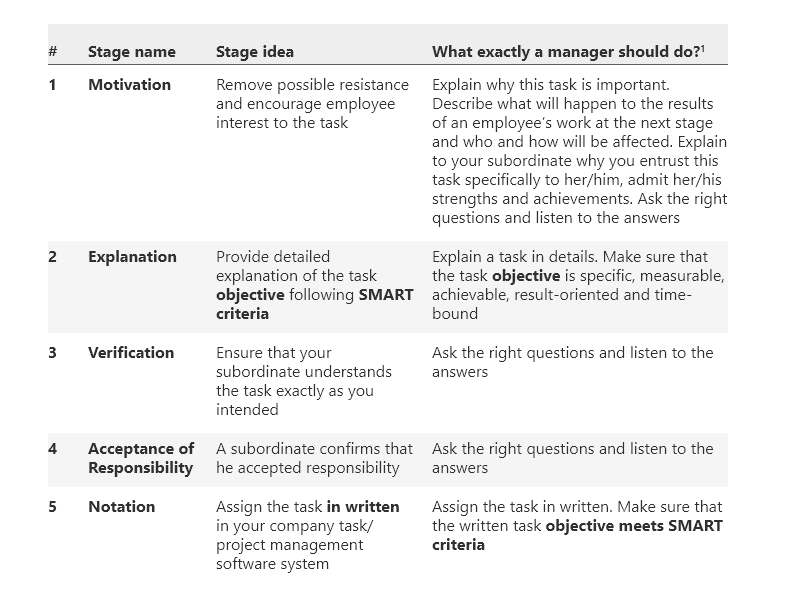
Source: Artem Albul, TWA Consulting
As we can see, task allocation, while the more “controlling” of the two, also gives in-depth instructions and asks for confirmation on task clarity. A lot of it comes down to everyone being on the same page, leaving little to no room for misinterpretation (but also creative freedom).
How should you allocate tasks?
With all that we’ve mentioned in the previous section, here’s how your task allotment could look like, step by step.
- Break down your project
Detail out the goals, objectives, and some individual tasks (not all, be careful not to start micromanaging). Place the most important deadlines.
- Prioritize tasks and sort them
It’s important to know what tasks need to be done faster/better, to properly allocate your resources and manpower from the start.
- Make a list of teams and team members
Assign team leaders (if you don’t have them), and alternatively, ask for their input on individual employees skills, for a more informed decision on who gets what.
- Schedule a meeting
Make a meeting with the team leads and go through the points above. Assign tasks according to each team’s availability, interest, and skill required to successfully push the project forward.
- As team leads – assign tasks further down the pipeline
- Track task completion and make necessary changes along the way
Whether it’s pushing deadlines, reassigning tasks, or shifting around resources. This is perfectly fine and expected, so long as it doesn’t happen on every task you’ve assigned. Then, it is an indicator of poor pre-planning.
- Offer feedback and write performances
Don’t forget to track the progress and make notes of important details that might help the next task allocation/delegation process. It’s also a useful piece of information for the employees on what they need to improve on.
Allocating tasks is somewhat more complicated than we want it to be. But, this kind of thorough research and preparation will make projects run more smoothly. Employees will also be more satisfied with their work, and there will be less hurdles as deadlines approach.
When should you delegate tasks?
Delegation is a great practice in trust for both the employer/supervisor and the employee. The employer learns how to give away some of their control over the process, while the employee learns how to take more accountability for their work.
This lets you focus on big-picture aspects of your job, since you deal less with assignments that are low-priority for you. You save time and energy, while helping others move up in their careers.
How do you effectively delegate tasks as a leader?
As we’ve mentioned, delegating includes more employee independence. There are some additional components which make this type of task assignment more appealing than allocation, with great opportunities for growth.
Focus on delegating objectives instead of actual tasks
When you delegate, you focus on the objective that needs to be done. You shouldn’t give employees a “color by numbers” instruction on how to complete a task.
Communicate clearly what the end result should be and what expectations you (or the higher-ups) have. Leave the means for reaching that end goal to the employees themselves. Because how you solve a task may be completely different to how they will. And that is perfectly fine, so long as the result is the one you are looking for.
Keep the objectives challenging
When the objectives you’re delegating are too easy, chances are the person will either procrastinate, or feel like you don’t trust them enough. And if they’re too difficult, they get frustrated, anxious, and begin to panic.
It’s a good idea to be aware of an employee’s skill level, so you can gauge how much challenge and responsibility they can take on. For them to be the most productive and achieve great results, they need to enter “the state of Flow”.

Source: Optimal Experience , M. Csikszentmihalyi
💡 We’ve discussed the state of Flow in more detail in an article on time organization.
Encourage discussion and feedback
Let employees voice their opinions on the topic.
They should ask anything about the task, the goals, or the overall impact their work will have on the later stages or others’ workflow. It means they are interested in the task, and getting involved.
And if they aren’t asking questions themselves, you can always nudge them into proactivity.
- Is there something you’d like me to clarify?
- Do you already have any ideas on how to go about the task?
- Is the time we agreed upon enough for you?
- Will you need other resources, tools, or support?
- Do you see any problems or risks?
Questions like these help them feel valued, their efforts acknowledged, and let them know you care about the task and how well they perform. Just be careful not to overdo it, or you’ll start to look like a micromanager.
Give employees free rein, but offer support
Speaking of micromanaging, delegation means you let people problem-solve their way out on their own. There should be no reason for a manager to step in and control or supervise any step of the process, unless absolutely necessary.
However, what you should do is let them know you’re available for any advice should they feel stuck. Just because employees get authority on a certain task, and are left to their own devices, doesn’t mean the project has to suffer until they pull themselves up.
From time to time, ask them if they need anything from you, and make sure they know you’re there for any kind of support, consultation, or mediation. ANother good practice is to also give them additional learning opportunities – such as training, conferences, courses, etc.
Delegate objectives that move people forward
Choose assignments that boost the skills and employ all of their experiences, instead of something that simply needs to be done. For example:
- Tasks that require they brush up on their team communication skills;
- Learning how to allocate smaller tasks;
- Supervising others’ work and doing quality control;
- Learning to work with a new tool;
- Holding a meeting (or more), etc.
Find out which skills your employees may want or need to develop, and then plan your delegations accordingly. You want them to complete the task while having learned something new at the same time.
How to choose who to delegate to
Paul Beesley, senior director and consultant at Beyond Theory proposed a nifty checklist for when you’re choosing an employee to delegate to. It’s meant to simplify and speed up the process.
To successfully complete the delegated task, your chosen employee needs:
S – the skill to perform and complete a task
T – the time to complete the task, and if needed, learn the required skill
A – the authority to handle everything concerning the task
R – the necessary level of responsibility
R – the recognition for successfully completing the task
This list is a set of important criteria that should be covered when you consider who to assign to a specific task. However, depending on your niche, type of service, company size and the project at hand, the criteria are likely to change. And it should accommodate your needs, not the other way around.
Common task delegation mistakes to avoid
With all being said, there are some common mistakes managers and employers make, sometimes without even realizing it.
- Being too vague concerning deadlines (using: as soon as possible, when you get to it, I need it by yesterday). It creates unnecessary pressure.
- Being unavailable for questions and concerns. While you shouldn’t micromanage, you should still be present for support if an employee feels stuck. Ignoring them or handing them over to someone else could cause distrust. However, if you are usually swamped with work, set consultation hours each day or week.
- Having unclear directions. Specifying the allotted time for task completion and expectations should be the bare minimum when delegating tasks.
- Not providing feedback. No feedback is worse than bad feedback. Employees need to be aware when they’re doing good work, as well. In one company I worked for, the mantra was: “If no one is complaining about your work, that means you’re doing good”. And while it sounds like sound logic, it actually caused a lot of frustration. We were left directionless, and simply “floating” from task to task, never knowing if any of them had a positive impact on our performance.
- Not listening to employees. Take into account how they feel about a task or the objective. Let them give you feedback and if there are potential problems from the get-go.
- Assigning other people to the same task. If you notice a person struggling, the first instinct should be to ask them how they’re faring, and if they need any help. Some managers tend to assign other employees to help them without consultation, which leaves a sore taste. The employee will feel even more incompetent and will be less likely to take on a similar task in the future.
- Assuming people will know what you mean. This is one of the biggest problems. When you’re formulating a task, be as clear as possible about the goals and expectations. Oftentimes managers think that these things are implied, but the truth is – no one is a mind reader. To avoid having information misconstrued or misunderstood, communicate clearly and directly.
There could be more mistakes, especially for every different field and industry. If at all possible, identify the most common ones, made either by you or your peers. Note down all the instances where certain tasks weren’t up to par, and see what you could have changed in your assignment process to fix it. Maybe there wasn’t enough time or resources, you were unclear, or the employee wasn’t ready for such responsibility. Use the same procedure in all future task delegations. It’s the only way to learn and make the process quicker.
Use Clockify to assign tasks with ease
Now you’re a master of task delegation — congrats!
But there’s more to it than meets the eye.
In fact, what if you used a digital tool like Clockify to increase the likelihood that each job would be completed on time and on point?
In Clockify, you can easily create highly descriptive assignments that contain information like:
- Start time,
- Billability status,
- Name of the employee,
- Period for getting the assignment done,
- Hours per day to spend on the assignment, and more.

That way, you can plan who works on what, how long, and when.
Similarly, Clockify allows you to create project milestones to achieve results faster.

With the Milestones option, you can select dates for deadlines, allowing you to pin down important events in your projects.
For example, if your client expects you to keep them in the loop about developments, you can inform them promptly on whether your team has reached the agreed-upon milestones.
Refocus on your company’s big picture with a project and time tracking tool.

Marijana Stojanovic is a writer and researcher who specializes in the topics of productivity and time management.
Where does the time go?
START TRACKING TIME
with Clockify

How to create a PTO policy
Everything you need to know about creating a PTO policy — from the basics of PTO to choosing a PTO tracking system that suits your workflow.
Working Overtime Without Pay – Know Your Rights and Options
Discover the legal and financial aspects of working overtime without pay. Learn your rights and how to handle common concerns regarding off-clock work.
PTO vs. Vacation: What Is the Difference?
Learn the difference between PTO and vacation and find out the answers to the most frequently asked questions regarding paid leave!
Best methods for tracking team productivity
Find out the most useful methods of tracking team productivity, followed by actual examples of how different teams measure their effectiveness.
Difference between a freelancer, a contractor, and an employee
Learn which work category you fall into, to better protect your rights as a worker and avoid worker exploitation.
10+ Life-changing tips to increase office productivity in 2023
Workplace distractions, stress, and poor performance are everywhere. Read this guide with life-changing tips to increase office productivity now!
FREE FOREVER • UNLIMITED USERS
Free time tracker
Time tracking software used by millions. Clockify is a time tracker and timesheet app that lets you track work hours across projects.
Teaching, Learning, & Professional Development Center
- Teaching Resources
- TLPDC Teaching Resources
How Do I Create Meaningful and Effective Assignments?
Prepared by allison boye, ph.d. teaching, learning, and professional development center.
Assessment is a necessary part of the teaching and learning process, helping us measure whether our students have really learned what we want them to learn. While exams and quizzes are certainly favorite and useful methods of assessment, out of class assignments (written or otherwise) can offer similar insights into our students' learning. And just as creating a reliable test takes thoughtfulness and skill, so does creating meaningful and effective assignments. Undoubtedly, many instructors have been on the receiving end of disappointing student work, left wondering what went wrong… and often, those problems can be remedied in the future by some simple fine-tuning of the original assignment. This paper will take a look at some important elements to consider when developing assignments, and offer some easy approaches to creating a valuable assessment experience for all involved.
First Things First…
Before assigning any major tasks to students, it is imperative that you first define a few things for yourself as the instructor:
- Your goals for the assignment . Why are you assigning this project, and what do you hope your students will gain from completing it? What knowledge, skills, and abilities do you aim to measure with this assignment? Creating assignments is a major part of overall course design, and every project you assign should clearly align with your goals for the course in general. For instance, if you want your students to demonstrate critical thinking, perhaps asking them to simply summarize an article is not the best match for that goal; a more appropriate option might be to ask for an analysis of a controversial issue in the discipline. Ultimately, the connection between the assignment and its purpose should be clear to both you and your students to ensure that it is fulfilling the desired goals and doesn't seem like “busy work.” For some ideas about what kinds of assignments match certain learning goals, take a look at this page from DePaul University's Teaching Commons.
- Have they experienced “socialization” in the culture of your discipline (Flaxman, 2005)? Are they familiar with any conventions you might want them to know? In other words, do they know the “language” of your discipline, generally accepted style guidelines, or research protocols?
- Do they know how to conduct research? Do they know the proper style format, documentation style, acceptable resources, etc.? Do they know how to use the library (Fitzpatrick, 1989) or evaluate resources?
- What kinds of writing or work have they previously engaged in? For instance, have they completed long, formal writing assignments or research projects before? Have they ever engaged in analysis, reflection, or argumentation? Have they completed group assignments before? Do they know how to write a literature review or scientific report?
In his book Engaging Ideas (1996), John Bean provides a great list of questions to help instructors focus on their main teaching goals when creating an assignment (p.78):
1. What are the main units/modules in my course?
2. What are my main learning objectives for each module and for the course?
3. What thinking skills am I trying to develop within each unit and throughout the course?
4. What are the most difficult aspects of my course for students?
5. If I could change my students' study habits, what would I most like to change?
6. What difference do I want my course to make in my students' lives?
What your students need to know
Once you have determined your own goals for the assignment and the levels of your students, you can begin creating your assignment. However, when introducing your assignment to your students, there are several things you will need to clearly outline for them in order to ensure the most successful assignments possible.
- First, you will need to articulate the purpose of the assignment . Even though you know why the assignment is important and what it is meant to accomplish, you cannot assume that your students will intuit that purpose. Your students will appreciate an understanding of how the assignment fits into the larger goals of the course and what they will learn from the process (Hass & Osborn, 2007). Being transparent with your students and explaining why you are asking them to complete a given assignment can ultimately help motivate them to complete the assignment more thoughtfully.
- If you are asking your students to complete a writing assignment, you should define for them the “rhetorical or cognitive mode/s” you want them to employ in their writing (Flaxman, 2005). In other words, use precise verbs that communicate whether you are asking them to analyze, argue, describe, inform, etc. (Verbs like “explore” or “comment on” can be too vague and cause confusion.) Provide them with a specific task to complete, such as a problem to solve, a question to answer, or an argument to support. For those who want assignments to lead to top-down, thesis-driven writing, John Bean (1996) suggests presenting a proposition that students must defend or refute, or a problem that demands a thesis answer.
- It is also a good idea to define the audience you want your students to address with their assignment, if possible – especially with writing assignments. Otherwise, students will address only the instructor, often assuming little requires explanation or development (Hedengren, 2004; MIT, 1999). Further, asking students to address the instructor, who typically knows more about the topic than the student, places the student in an unnatural rhetorical position. Instead, you might consider asking your students to prepare their assignments for alternative audiences such as other students who missed last week's classes, a group that opposes their position, or people reading a popular magazine or newspaper. In fact, a study by Bean (1996) indicated the students often appreciate and enjoy assignments that vary elements such as audience or rhetorical context, so don't be afraid to get creative!
- Obviously, you will also need to articulate clearly the logistics or “business aspects” of the assignment . In other words, be explicit with your students about required elements such as the format, length, documentation style, writing style (formal or informal?), and deadlines. One caveat, however: do not allow the logistics of the paper take precedence over the content in your assignment description; if you spend all of your time describing these things, students might suspect that is all you care about in their execution of the assignment.
- Finally, you should clarify your evaluation criteria for the assignment. What elements of content are most important? Will you grade holistically or weight features separately? How much weight will be given to individual elements, etc? Another precaution to take when defining requirements for your students is to take care that your instructions and rubric also do not overshadow the content; prescribing too rigidly each element of an assignment can limit students' freedom to explore and discover. According to Beth Finch Hedengren, “A good assignment provides the purpose and guidelines… without dictating exactly what to say” (2004, p. 27). If you decide to utilize a grading rubric, be sure to provide that to the students along with the assignment description, prior to their completion of the assignment.
A great way to get students engaged with an assignment and build buy-in is to encourage their collaboration on its design and/or on the grading criteria (Hudd, 2003). In his article “Conducting Writing Assignments,” Richard Leahy (2002) offers a few ideas for building in said collaboration:
• Ask the students to develop the grading scale themselves from scratch, starting with choosing the categories.
• Set the grading categories yourself, but ask the students to help write the descriptions.
• Draft the complete grading scale yourself, then give it to your students for review and suggestions.
A Few Do's and Don'ts…
Determining your goals for the assignment and its essential logistics is a good start to creating an effective assignment. However, there are a few more simple factors to consider in your final design. First, here are a few things you should do :
- Do provide detail in your assignment description . Research has shown that students frequently prefer some guiding constraints when completing assignments (Bean, 1996), and that more detail (within reason) can lead to more successful student responses. One idea is to provide students with physical assignment handouts , in addition to or instead of a simple description in a syllabus. This can meet the needs of concrete learners and give them something tangible to refer to. Likewise, it is often beneficial to make explicit for students the process or steps necessary to complete an assignment, given that students – especially younger ones – might need guidance in planning and time management (MIT, 1999).
- Do use open-ended questions. The most effective and challenging assignments focus on questions that lead students to thinking and explaining, rather than simple yes or no answers, whether explicitly part of the assignment description or in the brainstorming heuristics (Gardner, 2005).
- Do direct students to appropriate available resources . Giving students pointers about other venues for assistance can help them get started on the right track independently. These kinds of suggestions might include information about campus resources such as the University Writing Center or discipline-specific librarians, suggesting specific journals or books, or even sections of their textbook, or providing them with lists of research ideas or links to acceptable websites.
- Do consider providing models – both successful and unsuccessful models (Miller, 2007). These models could be provided by past students, or models you have created yourself. You could even ask students to evaluate the models themselves using the determined evaluation criteria, helping them to visualize the final product, think critically about how to complete the assignment, and ideally, recognize success in their own work.
- Do consider including a way for students to make the assignment their own. In their study, Hass and Osborn (2007) confirmed the importance of personal engagement for students when completing an assignment. Indeed, students will be more engaged in an assignment if it is personally meaningful, practical, or purposeful beyond the classroom. You might think of ways to encourage students to tap into their own experiences or curiosities, to solve or explore a real problem, or connect to the larger community. Offering variety in assignment selection can also help students feel more individualized, creative, and in control.
- If your assignment is substantial or long, do consider sequencing it. Far too often, assignments are given as one-shot final products that receive grades at the end of the semester, eternally abandoned by the student. By sequencing a large assignment, or essentially breaking it down into a systematic approach consisting of interconnected smaller elements (such as a project proposal, an annotated bibliography, or a rough draft, or a series of mini-assignments related to the longer assignment), you can encourage thoughtfulness, complexity, and thoroughness in your students, as well as emphasize process over final product.
Next are a few elements to avoid in your assignments:
- Do not ask too many questions in your assignment. In an effort to challenge students, instructors often err in the other direction, asking more questions than students can reasonably address in a single assignment without losing focus. Offering an overly specific “checklist” prompt often leads to externally organized papers, in which inexperienced students “slavishly follow the checklist instead of integrating their ideas into more organically-discovered structure” (Flaxman, 2005).
- Do not expect or suggest that there is an “ideal” response to the assignment. A common error for instructors is to dictate content of an assignment too rigidly, or to imply that there is a single correct response or a specific conclusion to reach, either explicitly or implicitly (Flaxman, 2005). Undoubtedly, students do not appreciate feeling as if they must read an instructor's mind to complete an assignment successfully, or that their own ideas have nowhere to go, and can lose motivation as a result. Similarly, avoid assignments that simply ask for regurgitation (Miller, 2007). Again, the best assignments invite students to engage in critical thinking, not just reproduce lectures or readings.
- Do not provide vague or confusing commands . Do students know what you mean when they are asked to “examine” or “discuss” a topic? Return to what you determined about your students' experiences and levels to help you decide what directions will make the most sense to them and what will require more explanation or guidance, and avoid verbiage that might confound them.
- Do not impose impossible time restraints or require the use of insufficient resources for completion of the assignment. For instance, if you are asking all of your students to use the same resource, ensure that there are enough copies available for all students to access – or at least put one copy on reserve in the library. Likewise, make sure that you are providing your students with ample time to locate resources and effectively complete the assignment (Fitzpatrick, 1989).
The assignments we give to students don't simply have to be research papers or reports. There are many options for effective yet creative ways to assess your students' learning! Here are just a few:
Journals, Posters, Portfolios, Letters, Brochures, Management plans, Editorials, Instruction Manuals, Imitations of a text, Case studies, Debates, News release, Dialogues, Videos, Collages, Plays, Power Point presentations
Ultimately, the success of student responses to an assignment often rests on the instructor's deliberate design of the assignment. By being purposeful and thoughtful from the beginning, you can ensure that your assignments will not only serve as effective assessment methods, but also engage and delight your students. If you would like further help in constructing or revising an assignment, the Teaching, Learning, and Professional Development Center is glad to offer individual consultations. In addition, look into some of the resources provided below.
Online Resources
“Creating Effective Assignments” http://www.unh.edu/teaching-excellence/resources/Assignments.htm This site, from the University of New Hampshire's Center for Excellence in Teaching and Learning, provides a brief overview of effective assignment design, with a focus on determining and communicating goals and expectations.
Gardner, T. (2005, June 12). Ten Tips for Designing Writing Assignments. Traci's Lists of Ten. http://www.tengrrl.com/tens/034.shtml This is a brief yet useful list of tips for assignment design, prepared by a writing teacher and curriculum developer for the National Council of Teachers of English . The website will also link you to several other lists of “ten tips” related to literacy pedagogy.
“How to Create Effective Assignments for College Students.” http:// tilt.colostate.edu/retreat/2011/zimmerman.pdf This PDF is a simplified bulleted list, prepared by Dr. Toni Zimmerman from Colorado State University, offering some helpful ideas for coming up with creative assignments.
“Learner-Centered Assessment” http://cte.uwaterloo.ca/teaching_resources/tips/learner_centered_assessment.html From the Centre for Teaching Excellence at the University of Waterloo, this is a short list of suggestions for the process of designing an assessment with your students' interests in mind. “Matching Learning Goals to Assignment Types.” http://teachingcommons.depaul.edu/How_to/design_assignments/assignments_learning_goals.html This is a great page from DePaul University's Teaching Commons, providing a chart that helps instructors match assignments with learning goals.
Additional References Bean, J.C. (1996). Engaging ideas: The professor's guide to integrating writing, critical thinking, and active learning in the classroom . San Francisco: Jossey-Bass.
Fitzpatrick, R. (1989). Research and writing assignments that reduce fear lead to better papers and more confident students. Writing Across the Curriculum , 3.2, pp. 15 – 24.
Flaxman, R. (2005). Creating meaningful writing assignments. The Teaching Exchange . Retrieved Jan. 9, 2008 from http://www.brown.edu/Administration/Sheridan_Center/pubs/teachingExchange/jan2005/01_flaxman.pdf
Hass, M. & Osborn, J. (2007, August 13). An emic view of student writing and the writing process. Across the Disciplines, 4.
Hedengren, B.F. (2004). A TA's guide to teaching writing in all disciplines . Boston: Bedford/St. Martin's.
Hudd, S. S. (2003, April). Syllabus under construction: Involving students in the creation of class assignments. Teaching Sociology , 31, pp. 195 – 202.
Leahy, R. (2002). Conducting writing assignments. College Teaching , 50.2, pp. 50 – 54.
Miller, H. (2007). Designing effective writing assignments. Teaching with writing . University of Minnesota Center for Writing. Retrieved Jan. 9, 2008, from http://writing.umn.edu/tww/assignments/designing.html
MIT Online Writing and Communication Center (1999). Creating Writing Assignments. Retrieved January 9, 2008 from http://web.mit.edu/writing/Faculty/createeffective.html .
Contact TTU

Assign and track tasks
In addition to creating your own tasks, you can create tasks to assign to others.
Tasks help track things you need to do. You can assign tasks to other people as well.
On the navigation bar, click Tasks , and then click New Task , or open an existing task.
Keyboard shortcut To create a task, press Ctrl+Shift+K.
Click Assign Task .

In the To box, enter a name or an email address.
Enter Subject , Start date , and Due date .

If you want the task to repeat, click Recurrence , select the options you want, and then click OK .
Click Send .
Note: If you assign a recurring task, a copy of the task remains in your task list, but it never updates. If you check the Send me a status report when this task is complete box, you receive status reports for each completed occurrence of the task.
When you open a task you assigned, you can review the progress of assigned tasks with the % Complete box which either you or the recipient can update when they send you an assigned task status report.
Note: Tasks assigned from Outlook for Windows must be accepted or declined using the Outlook for Windows application. This experience is not supported in Outlook on the web.
Assigning tasks to multiple people
Outlook can track the progress of a task assigned to one person. If you want to multiple people to work on a task, it’s a good idea to divide the task into smaller pieces or assign each task individually. For example, to track a report to be written by three writers, create three separate tasks named Write Report: Anne , Write Report: Carlos , and Write Report: Michiyo , and assign each individual task to the appropriate writer.
Track tasks you've assigned to someone else
On the navigation bar, click Tasks .
Click View > Change View > Assigned .

Assigned tasks are missing
If you’re not seeing tasks you’ve assigned, Outlook might not be set up to keep copies of tasks you assign.
Click File > Options > Tasks .
Under Task options , check the Keep my task list updated with copies of tasks I assign to other people box.
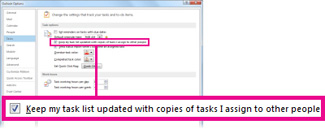
Turning on this option doesn’t track the tasks you’ve already assigned, but it will track any new ones you assign.

Need more help?
Want more options.
Explore subscription benefits, browse training courses, learn how to secure your device, and more.

Microsoft 365 subscription benefits

Microsoft 365 training

Microsoft security

Accessibility center
Communities help you ask and answer questions, give feedback, and hear from experts with rich knowledge.

Ask the Microsoft Community

Microsoft Tech Community

Windows Insiders
Microsoft 365 Insiders
Was this information helpful?
Thank you for your feedback.

Microsoft Planner
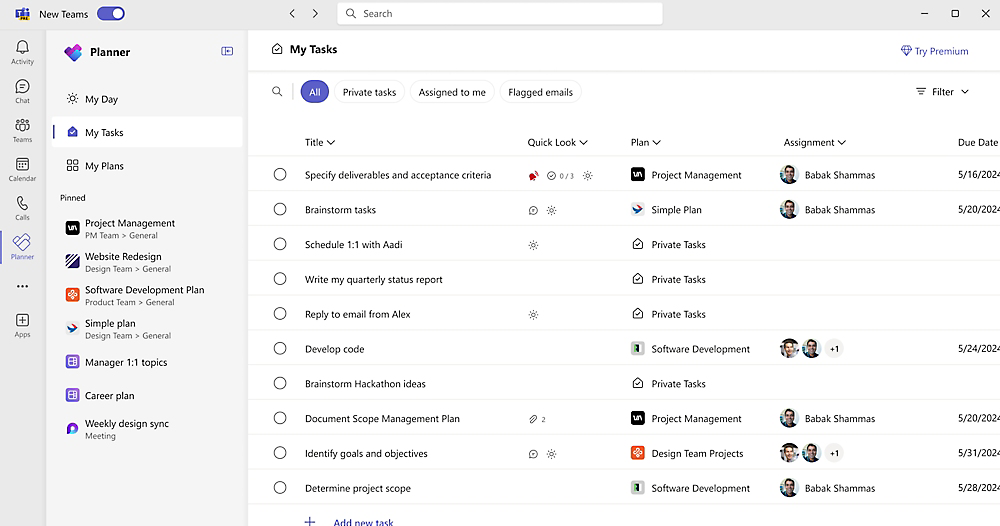
Work management in one simple experience
Share, chat, and meet, accomplish more today.

Access work faster
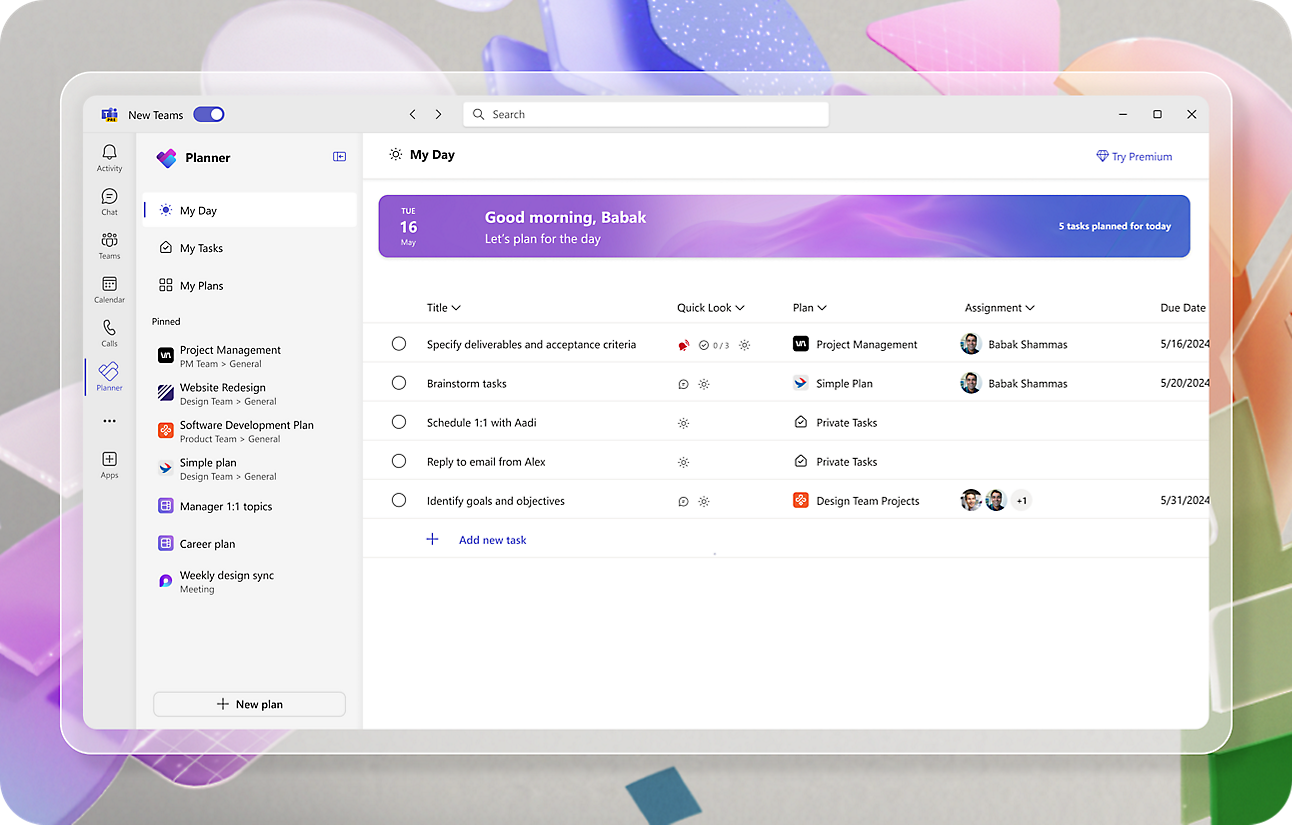
Work the way you want
Manage work together.
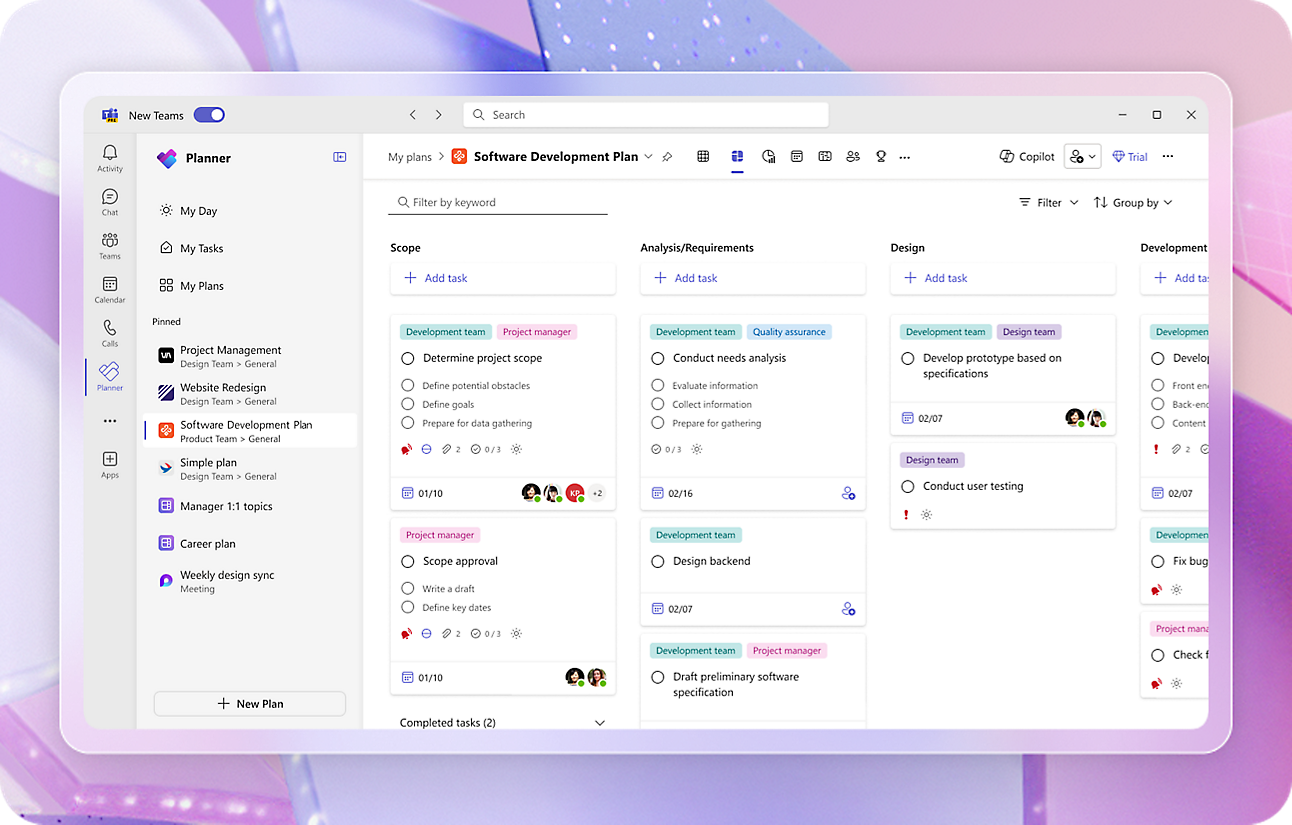
Enjoy familiar features

Power your plans—big and small
Focus on the big picture.

Get big picture views
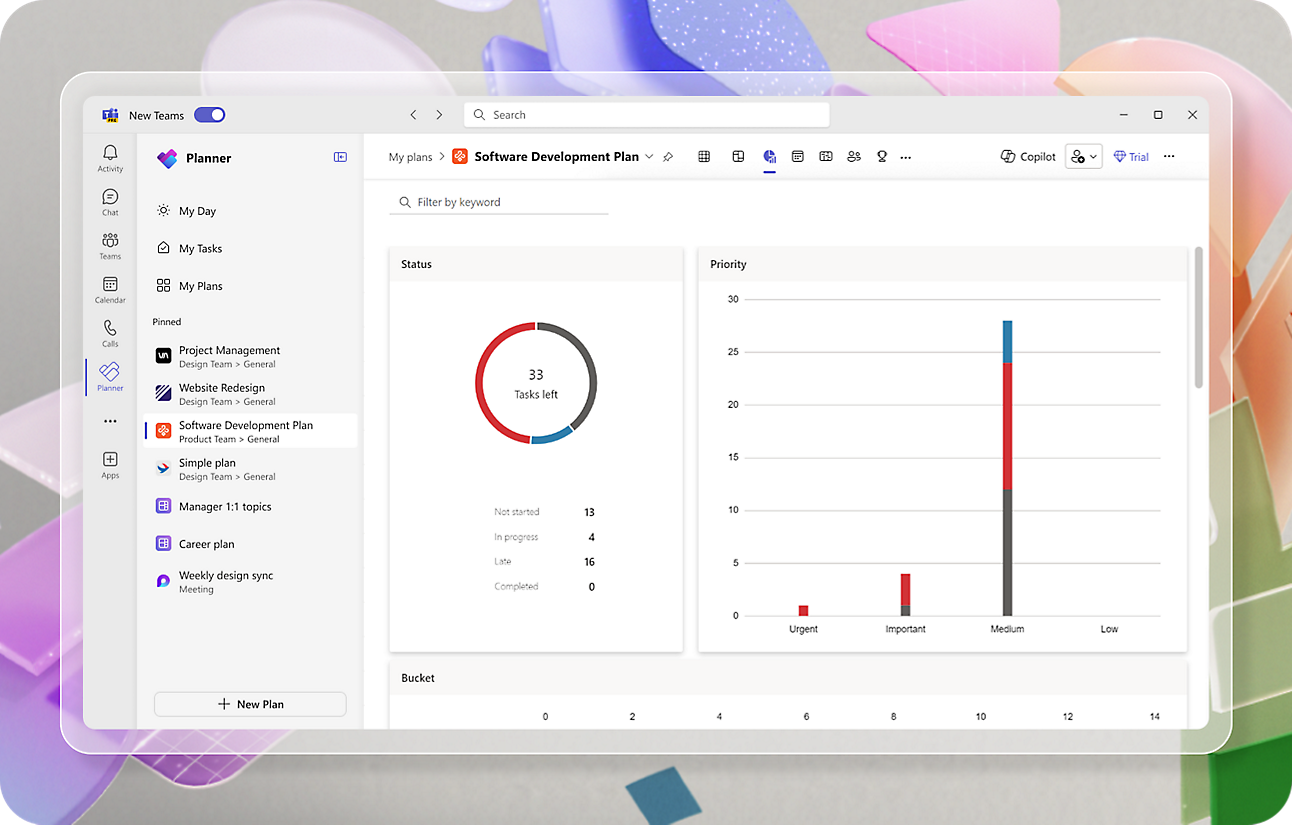
Make a bigger impact
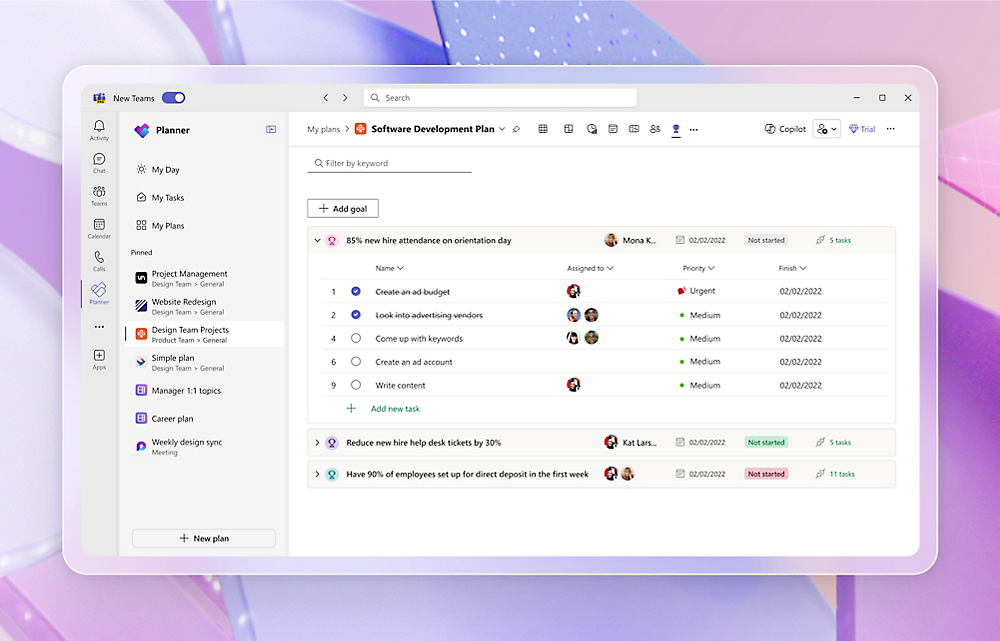
Plan with Copilot

Set goals with Copilot

Stay informed with Copilot

Take your plans with you
Microsoft Loop
Microsoft Outlook
Microsoft Teams
Microsoft Viva Goals

Feel more accomplished every day

Choose your plan
Planner in microsoft 365.
- Creation and management of content-rich tasks
- My Day, My Tasks and Assigned to Me views
- Basic plan templates
- Microsoft Teams integration
- List, Grid, and Board views
Planner Plan 1
Everything in planner in microsoft 365, plus:.
- Task dependencies
- Premium plan templates
- Timeline (Gantt) view
- Backlogs and sprints
- People management
- Project goals
Project Plan 3
Includes everything in planner plan 1, plus:.
- Copilot in Planner (preview) 2
- Advanced dependencies with lead and lag
- Resource request capabilities
- Task history
- Program management and demand management
- Project Online and Project Online desktop client
Project Plan 5
Includes everything in project plan 3, plus:.
- Portfolio management
- Enterprise resource management and allocation
Security and data privacy built in

Stay up to date with Planner

Explore resources to help improve work management across your organization with Planner.

See updates about Planner in the Tech Community blog.
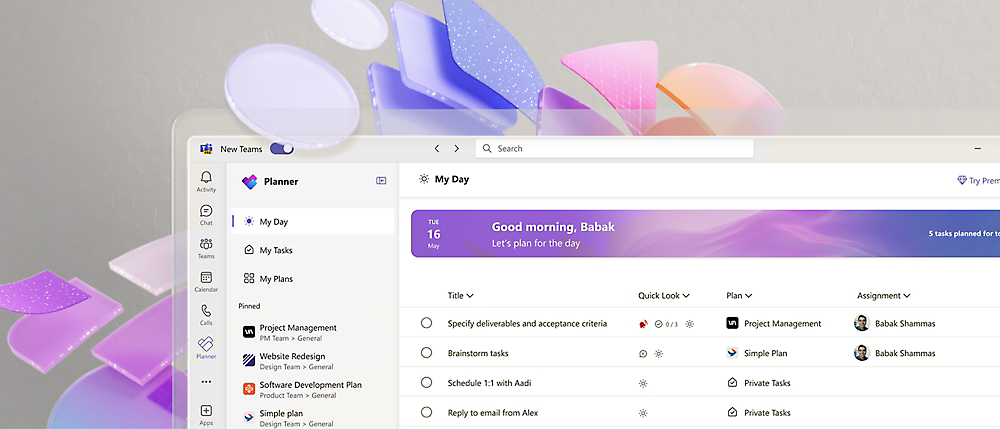
Learn about the latest Planner features.

See Planner in action in product demos.

Learn more about Planner.
Learn how customers are improving work management.

“Having a standardized way of working with a cloud solution like the Project and Portfolio Management (PPM) platform we built with Project for the web speaks to the new ways of working.”

“We’re in a highly collaborative environment with small teams, and the work we do is high volume and high impact. Microsoft Project for the web and its integrations are really complementary to how we work.”

“Now that we have a unified system with Project for the web, project managers have one place to manage their projects.”
Frequently asked questions
Why is microsoft launching a new planner experience, how does the announcement of the new planner impact existing project customers, when will the new planner web experience be available, i already moved to project for the web. what will happen to my work, is there any change in pricing with this announcement, what changes should customers currently using project for the web, planner, and the tasks by planner and to do app in teams expect to see, will microsoft project be retired, for customers currently using project for the web, are there added benefits to using the new planner.
- New enterprise work management capabilities.
- Copilot in Planner (preview) - see plans and pricing .
- The simplicity of To Do, the collaboration of Planner, and the versatility of Project for the web in one simple, familiar experience.
- Clean, intuitive design.
Who can install the new Microsoft Planner?

See what’s possible with Microsoft Planner
See plans and pricing
Explore adoption documentation
[ 1 ] A credit card is required to begin a one-month trial. The duration of the trial varies by the month you sign up. The expiration date will appear on the trial subscription details page within the Microsoft 365 admin center. Upon expiration of your one-month trial, you’ll be charged the applicable subscription fee. Cancel any time to stop future charges.
[ 2 ] While final pricing for Copilot in Planner has not been announced, users with a Project Plan 3 or Project Plan 5 license will be able to preview Copilot in Planner capabilities once it is rolled out to their organization.
Follow Microsoft 365
- Defining and Managing Financial Projects
Burden Schedule Task Assignment Options
A burden schedule is specified at the project type, project, or task level. When you change the burden schedule, you can propagate the change from the project to all existing tasks. You can change the burden schedule assignment on the project and tasks independently.
Assign the burden schedule to new tasks only
Assign the burden schedule to all tasks
Assign the burden schedule to tasks with previously assigned schedule
Assign Burden Schedule to New Tasks Only
The changed burden schedule is applied to new top tasks only. New subtasks always inherit the burden schedule assignment from the parent task. The burden schedule change doesn't affect the existing tasks or tasks with an existing override.
Assign Burden Schedule to All Tasks
The changed burden schedule is applied to all existing tasks. Existing burden schedule overrides don't change.
Assign Burden Schedule to Tasks with Previously Assigned Schedule
The changed burden schedule applies only to existing tasks that have the same burden schedule that was assigned to the project before this change. The changed burden schedule isn't applied on tasks with an existing burden schedule override.
Synonyms of assignments
- as in tasks
- as in missions
- as in lessons
- as in appointments
- More from M-W
- To save this word, you'll need to log in. Log In
Thesaurus Definition of assignments
Synonyms & Similar Words
- responsibilities
- undertakings
- enterprises
- commissions
- requirements
- obligations
- commitments
- appointments
- constraints
- designations
- nominations
- compulsions
- installments
- delegations
- authorizations
- investments
- installations
- instalments
- destinations
- emplacements
- ordinations
- deputations
- investitures
- anointments
Antonyms & Near Antonyms
- depositions
- dismissions
- dethronements
Thesaurus Entries Near assignments
assignments
Cite this Entry
“Assignments.” Merriam-Webster.com Thesaurus , Merriam-Webster, https://www.merriam-webster.com/thesaurus/assignments. Accessed 2 May. 2024.
More from Merriam-Webster on assignments
Nglish: Translation of assignments for Spanish Speakers
Britannica English: Translation of assignments for Arabic Speakers
Subscribe to America's largest dictionary and get thousands more definitions and advanced search—ad free!

Can you solve 4 words at once?
Word of the day.
See Definitions and Examples »
Get Word of the Day daily email!
Popular in Grammar & Usage
What’s the difference between ‘hillbilly’ and ‘redneck’, more commonly misspelled words, commonly misspelled words, how to use em dashes (—), en dashes (–) , and hyphens (-), absent letters that are heard anyway, popular in wordplay, the words of the week - apr. 26, 9 superb owl words, 'gaslighting,' 'woke,' 'democracy,' and other top lookups, 10 words for lesser-known games and sports, your favorite band is in the dictionary, games & quizzes.


IMAGES
VIDEO
COMMENTS
A task is something you have to do. An assignment is usually a task that someone gives you to do. Ways to use 'task'. A task describes an activity that can be done in your daily life. But you ...
Improving one's understanding and use of task and assignment requires practice. Here are some exercises to help readers do just that: Exercise 1: Identifying Tasks And Assignments. Below are ten sentences. For each sentence, identify whether the underlined word represents a task or an assignment. Write "T" for task and "A" for assignment.
Task, project, assignment, job. Which one is correct in my case? These words don't have exact matches in Portuguese, so sometimes I get confused about their usage. When is it more suitable to use task rather than assigment and vice versa?
Synonyms for ASSIGNMENT: task, job, duty, project, mission, chore, responsibility, function; Antonyms of ASSIGNMENT: dismissal, discharge, firing, expulsion ...
In computing terms the difference between task and assignment is that task is a process or execution of a program while assignment is an operation that assigns a value to a variable. As nouns the difference between task and assignment is that task is a piece of work done as part of one's duties while assignment is the act of assigning; the allocation of a job or a set of tasks.
How to use assignment in a sentence. Synonym Discussion of Assignment. the act of assigning something; a position, post, or office to which one is assigned… See the full definition. Games & Quizzes; Games & Quizzes; Word of the Day ... a specified task or amount of work assigned or undertaken as if assigned by authority. a homework assignment ...
Project / Task / Assignment / Job. The way I see it, a project is comprised of several tasks, and each task becomes an assignment after it has been assigned to a specific individual or team. (Job is better applied to each employee's position in the company). With that in mind, I think assignment is the proper word for your bulletin board.
What this handout is about. The first step in any successful college writing venture is reading the assignment. While this sounds like a simple task, it can be a tough one. This handout will help you unravel your assignment and begin to craft an effective response. Much of the following advice will involve translating typical assignment terms ...
[countable] a task or piece of work that somebody is given to do, usually as part of their job or studies. Students are required to complete all homework assignments. You will need to complete three written assignments per semester. a business/special assignment ; I had set myself a tough assignment.
assignment in American English. (əˈsainmənt) noun. 1. something assigned, as a particular task or duty. She completed the assignment and went on to other jobs. 2. a position of responsibility, post of duty, or the like, to which one is appointed. He left for his assignment in the Middle East.
7 meanings: 1. something that has been assigned, such as a mission or task 2. a position or post to which a person is assigned.... Click for more definitions.
Key Differences. A task refers to any piece of work or activity that needs to be done, typically implying a shorter, more immediate piece of work that can be part of daily responsibilities or projects. Whereas, an assignment is a piece of work or project allocated to someone, often as part of their studies or job, usually with a clear objective ...
Assign tasks: Open the desired task, click "Assignee", and choose the right team member (s). Keyboard shortcuts: Hover over the task and press "A" to open the Assignee picker. Press the space bar to assign yourself.
ASSIGNMENT definition: 1. a piece of work given to someone, typically as part of their studies or job: 2. a job that…. Learn more.
Task assigning involves defining responsibilities and allocating resources for team members to complete a project effectively. While workplace leaders can assign tasks to team members in different departments, managers typically assign tasks to their department's members. Discovering each team member's strengths, potential, and expertise can ...
Make a meeting with the team leads and go through the points above. Assign tasks according to each team's availability, interest, and skill required to successfully push the project forward. As team leads - assign tasks further down the pipeline. Track task completion and make necessary changes along the way.
Synonyms for TASK: job, duty, assignment, project, chore, mission, function, responsibility, endeavor, errand
Delegating tasks is another helpful strategy for task management, but knowing who to assign tasks to and how to delegate them is equally important. Provide clear, specific instructions and expectations and offer support along the way. Appropriate delegation can help your team work better together and soften the workload on any one person.
By sequencing a large assignment, or essentially breaking it down into a systematic approach consisting of interconnected smaller elements (such as a project proposal, an annotated bibliography, or a rough draft, or a series of mini-assignments related to the longer assignment), you can encourage thoughtfulness, complexity, and thoroughness in ...
A task refers to a specific action or assignment that needs to be completed. It is a discrete unit of work with a clear objective and a defined set of steps. Tasks are often smaller in scale and can be accomplished within a relatively short period. They are typically part of a larger project or goal, contributing to its overall completion.
A job interview assignment is a task or project related to the position you're applying for. Many hiring managers use these assignments in addition to a traditional interview to learn more about your skills and work ethic and evaluate how your abilities align with the job requirements. These assignments may not be the exact type of work you ...
Tasks help track things you need to do. You can assign tasks to other people as well. On the navigation bar, click Tasks, and then click New Task, or open an existing task. Keyboard shortcut To create a task, press Ctrl+Shift+K. Click Assign Task. In the To box, enter a name or an email address. Enter Subject, Start date, and Due date.
Synonyms for ASSIGN: task, entrust, charge, trust, impose, intrust, confer, allocate; Antonyms of ASSIGN: deny, retain, deprive (of), withhold, keep, begrudge ...
Assign training and policy tasks to frontline employees (task list for each team member) 2. Automatically send repeat tasks to frontline locations (task list recurrence) 3. Make it mandatory to provide input back to the org (form completion requirement) 4. Make it mandatory to get approval for work completed (approval completion requirement)
Individual workers, team leaders and professional project managers are asking for a simple, consolidated work management solution that can flex and scale to meet their needs.The new Planner brings together task management, collaborative work management, and enterprise work management into a single experience.
A burden schedule is specified at the project type, project, or task level. When you change the burden schedule, you can propagate the change from the project to all existing tasks. You can change the burden schedule assignment on the project and tasks independently.
Synonyms for ASSIGNMENTS: tasks, duties, jobs, projects, chores, missions, responsibilities, functions; Antonyms of ASSIGNMENTS: dismissals, firings, discharges ...
When creating a task in BIM 360 Field (Classic) the task will auto-assign to a project member. Is there any way to create a task without the task being auto-assigned? By design, tasks created within BIM 360 Field (Classic) cannot be created without being assigned to project member. When an assignee is not explicitly selected, the task will be auto-assigned to the primary project admin set for ...
Need help with an assignment, a piece of code, writing an essay or preparing for a test… whatever the task i...". STEMinsights - The Invisible Hand💡 | Got a last minute project? Need help with an assignment, a piece of code, writing an essay or preparing for a test… whatever the task i... | Instagram